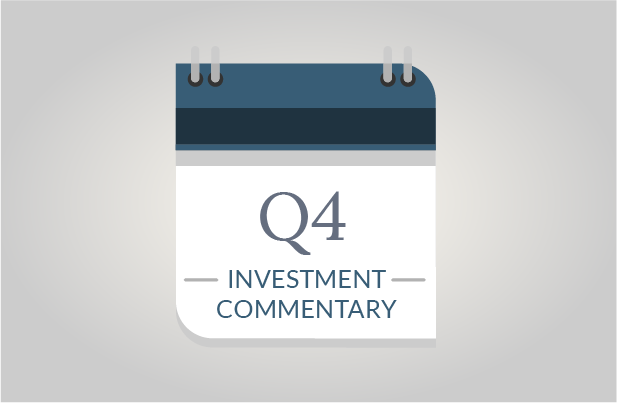SageVest Wealth Management’s latest quarterly commentary is now available. Highlights include:
– World stock markets embark on a roller coaster ride, posting significant losses by year-end.significant losses by year-end.
– Trade war tensions intensify, with high stakes ahead.
– Bonds surprise to the upside, but with foreboding signs as the yield curve partially inverts while debt levels soar.
Volatility Returns
If there was one key characteristic of 2018, it was the return of volatility. The 2017 upward trajectory continued in January, but was quickly upended with a sharp downturn in stocks. The good times rolled again through summer, with two historic milestones. The S&P 500 celebrated the longest bull market since World War II, and Amazon became the first company to top $1 trillion in market value. There was much to celebrate, except the celebration was cut short with the onset of the fourth quarter. The jubilee evaporated quickly, sending markets into correction territory (marked by a 10 percent decline) and some into bear market territory (marked by a 20 percent or greater decline).
The S&P 500, which was up about 9 percent for the year, ended the year down more than 6 percent.International stocks suffered far greater losses, with the MSCI World Index, excluding the U.S., being down more than 14 percent.
Fears about the impacts of trade wars, rising interest rates, slowing global demand, a precipitous drop in oil and a softening in the housing market were a few of the key variables that led to the downturn.
We’re elated that we took profits during the upturn and explore our thoughts moving into 2019.
Trade War Tensions
Perhaps the biggest financial story of 2018 was the onset of trade war tensions.President Trump followed through on his campaign rhetoric of addressing trade imbalances. He initiated several trade spats, most notably with China, the second largest economy in the world and a significant exporter to the United States.
President Trump’s trade intentions are multifaceted, intended to safeguard our military standing and improve our economy. However, they are significantly disrupting global growth, demand and production across a multitude of sectors, at least on a temporary basis.
Businesses spanning many industries are unsure how to plan, manage or act, as trade and pricing uncertainty looms. And, if there’s one thing businesses and the markets don’t like, its uncertainty.
We’re currently in a 90-day truce period with China, while both countries work to achieve trade agreements, with heavy impending consequences if they fail. Hence, the pressure is on.
While nothing is ever certain, we are hopeful that an agreement can be reached for two important reasons:
- President Trump is a business man. Despite varying viewpoints, there’s one thing just about everyone can agree upon; he’s pro-business. We believe he’s keenly attuned to disruptions in the economy and the markets, with an objective of reinvigorating growth.
- China’s economy is suffering. China’s stock market was down more than 20 percent in 2018, and its economy is expected to record its slowest growth rate in 28 years. They’re feeling the impacts of a trade war, with heavy incentives for a truce.
If an agreement is reached, the markets and the economy could be ready to roar once gain. There’s certainly a lot at stake.
Tech, Tech, Tech or Tick, Tick, Tock?
Another large story of 2018 was technology. We offered a word of caution in our third quarter commentary that technology stocks might have been too red hot. While it’s challenging to predict the markets, our cautionary words were rather timely. The technology sector that was the rage of the markets, with just a handful of stocks representing the lion’s share of S&P 500 returns, took a major tumble in the fourth quarter. Just about the only broad asset that performed worse was oil, which tumbled more than 40 percent.
As we stated in the third quarter, technology will continue to lead our economies and our lives, but prices were getting ahead of themselves, a bit like the exuberance we saw in the late 1990s. This is a classic time to remind investors that no sector remains on top forever, illustrating the potential perils of concentrating investments in what’s hot.
A Dramatic Reversal In Bonds
Bonds offered the reverse example, as they experienced a dramatic upswing as stocks fell under pressure. Those who complained about bonds being down two to three percent over the summer were quickly reminded that stocks can suffer such losses in one single day. Assets flocked to safety during turbulence, pushing long-term yields dramatically lower and many bond indices into positive territory for the year.
A Partial Inversion Of The Yield Curve
We talked about the importance of watching the yield curve throughout 2018, particularly looking for an inversion (when long-term rates fall below short-term rates). This has historically been a foreboding sign for both the markets and the economy.
The belly of the yield curve (the 5-year minus 2-year Treasury spread) inverted in the fourth quarter. It’s important to note that the longer term yield curve, the spread between the 10-year and the 3-month Treasury yields, remains modestly upward sloping. This is encouraging. However, we are cognizant of the fact that the spread is incredibly tight, potentially putting us on the precipice of a full inversion if long-term rates continue to dive lower and/or the Fed continues raising short-term rates.
Unprecedented Debt Levels
While we hate to belabor the topic of bonds, we feel it necessary to discuss unprecedented debt levels. World debt levels, now totaling nearly $250 trillion, have never been higher. The good times of a low interest rate environment rolled for years, and debt issuance rolled right along with it as money was dirt cheap. Debt has amassed among companies, governments and households alike. While heightened borrowing can spark growth, which we saw in recent years, it can also lead to problems when debt levels swell too large.
It’s important to keep in mind that most of the world’s debt is very different than a traditional mortgage, as there’s no embedded principal payment. Corporate and government debt payments are interest only until the bond is due, at which time the full amount needs to be repaid, or reissued.
The Fed is trying to unwind its balance sheet by selling government debt at the same time when many companies and governments must rollover aging debt. This means we need a lot of bond buyers to come to the table in the coming years.
We’re not prognosticating problems, but we are wary of debt levels and feel they warrant a cautionary note as we enter 2019.
Looking Forward
As we look to the year ahead, we can make the case for a market rebound if we get a trade deal, and we’re encouraged by the economy remaining strong. That said, we could also foresee the onset of a bear market and even a recession. We’ve been buying on market dips and will continue to look for buying opportunities, while always remaining cognizant of client liquidity needs and long-term investment objectives.
We’ve reached out to all clients to touch base in recent weeks and months, and encourage you to remain in contact with us should you have any questions or concerns. We always respect the trust you place in us as your investment and wealth managers.




